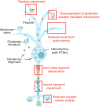Tau-mediated synaptic and neuronal dysfunction in neurodegenerative disease
- PMID: 29753269
- PMCID: PMC6130905
- DOI: 10.1016/j.conb.2018.04.027
Tau-mediated synaptic and neuronal dysfunction in neurodegenerative disease
Abstract
The accumulation of pathological tau in the brain is associated with neuronal deterioration and cognitive impairments in tauopathies including Alzheimer's disease. Tau, while primarily localized in the axons of healthy neurons, accumulates in the soma and dendrites of neurons under pathogenic conditions. Tau is found in both presynaptic and postsynaptic compartments of neurons in Alzheimer's disease. New research supports that soluble forms of tau trigger pathophysiology in the brain by altering properties of synaptic and neuronal function at the early stages of disease progression, before neurons die. Here we review the current understanding of how tau-mediated synaptic and neuronal dysfunction contributes to cognitive decline. Delineating the mechanisms by which pathogenic tau alters synapses, dendrites and axons will help lay the foundation for new strategies that can restore neuronal function in tauopathy.
Copyright © 2018 Elsevier Ltd. All rights reserved.
Figures

References
-
- Ingelsson M, Fukumoto H, Newell KL, Growdon JH, Hedley-Whyte ET, Frosch MP, Albert MS, Hyman BT, Irizarry MC. Early Abeta accumulation and progressive synaptic loss, gliosis, and tangle formation in AD brain. Neurology. 2004;62:925–931. - PubMed
-
- Giannakopoulos P, Herrmann FR, Bussiere T, Bouras C, Kovari E, Perl DP, Morrison JH, Gold G, Hof PR. Tangle and neuron numbers, but not amyloid load, predict cognitive status in Alzheimer’s disease. Neurology. 2003;60:1495–1500. - PubMed
-
- Kowall NW, Kosik KS. Axonal disruption and aberrant localization of tau protein characterize the neuropil pathology of Alzheimer’s disease. Ann Neurol. 1987;22:639–643. - PubMed
-
- Forner S, Baglietto-Vargas D, Martini AC, Trujillo-Estrada L, LaFerla FM. Synaptic Impairment in Alzheimer’s Disease: A Dysregulated Symphony. Trends Neurosci. 2017;40:347–357. - PubMed
Publication types
MeSH terms
Substances
Grants and funding
LinkOut - more resources
Full Text Sources
Other Literature Sources
Medical

